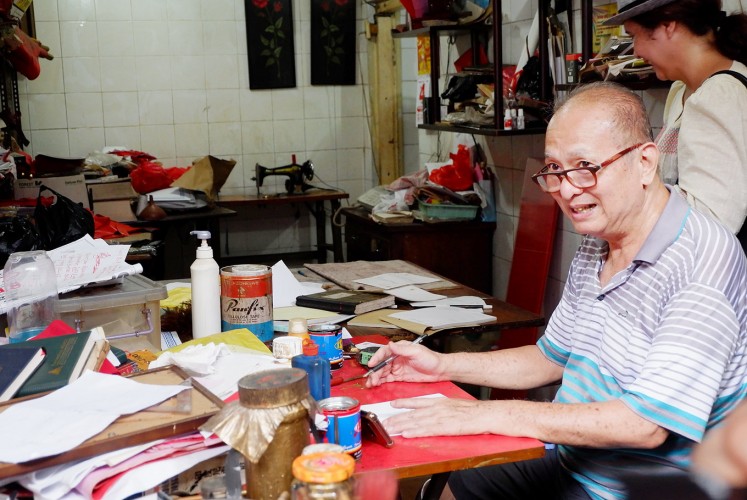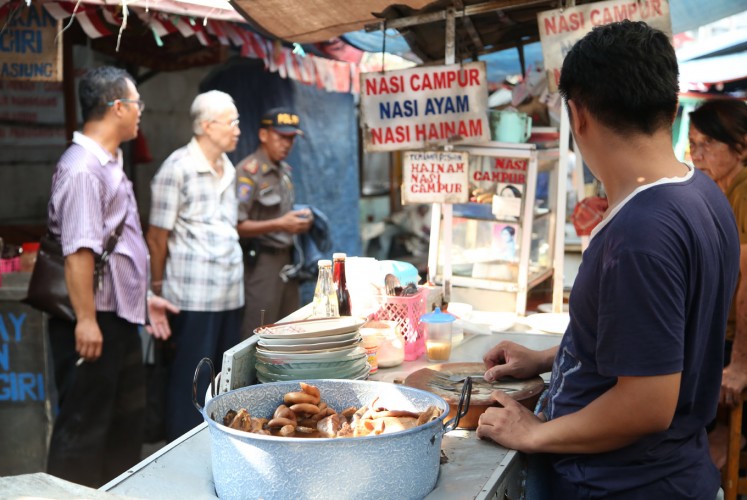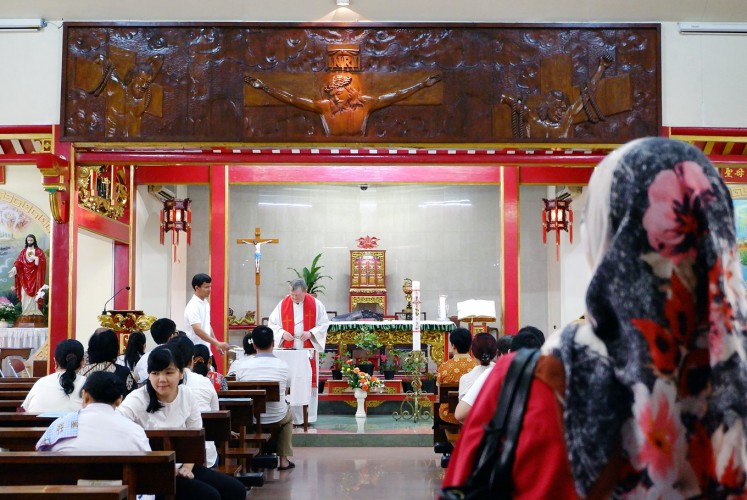Popular Reads
Top Results
Can't find what you're looking for?
View all search resultsPopular Reads
Top Results
Can't find what you're looking for?
View all search resultsChinese New Year: Learning about the past from the present
Behind its bustling atmosphere and mouth-watering food all around, Glodok — Jakarta’s popular Chinatown area — is a witness to bitter history.
Change text size
Gift Premium Articles
to Anyone
Lim Tju Kuet will not celebrate this year’s Chinese New Year, which ushers in the Year of the Dog this Friday, with his children.
Both his son and daughter have given up their Indonesian citizenship to become Australian citizens to pursue their careers as accountants. “They are still traumatized,” said the 72-year-old Chinese calligraphy artist, fondly known as Akwet.
He was referring to the dark time when fires were gutting houses and hotels in the Glodok area back in May 1998, making his children scared to go home after school because of the riots.
He felt deep gratitude for a Muslim man who sheltered his children in his house at the back of their school while waiting for the situation to calm.
In the past few days, Akwet was busy writing “Gong xi fa cai” — a wish for a prosperous New Year — onto postcards in his studio, located near the 260-year-old Dharma Jaya Temple, also known as Toa Se Bio.
Such a sight was impossible during the New Order era, when Chinese-Indonesians were discriminated against and Akwet had to work in secrecy, as the government had banned not only his culture and tradition but also his language.
“We will also prepare candy, peanuts, fruit and new clothes for the New Year,” he told participants of a food tour organized by the Jakarta Food Traveler (JFT) community.
Man of art: Calligraphy artist Akwet works at his studio in Glodok. (JP/A. Kurniawan Ulung)The tour stopped at his studio on the way to the famed Gang (Alley) Kali Mati, home to Glodok’s mouth-watering culinary treasures.
Guided by JFT founder Ira Lathief, the participants explored Glodok’s popular food spots, from Pantjoran Tea House, to Gang Gloria, to Dharma Bhakti Vihara.
As the Chinese New Year inched closer, the shops turned brighter, sparkling in gold and pink ornaments along with red paper lanterns. All around, shops offered angpao (red envelopes) for money, firecrackers, fireworks and kue keranjang (glutinous cake).
Nearby, traders also offered sea cucumber — one of eight basic ingredients to cook “eight-treasure soup”, a special dish for the family dinner. The celebration day is, for those who celebrate it, a symbol of hope and prosperity.
On the Chinese calendar, Chinese New Year, or Imlek, is the most significant holiday. In Indonesia, thanks to former president Megawati Soekarnoputri, it has been celebrated as a national holiday since 2003. She followed the actions of her predecessor, then-president Abdurrahman “Gus Dur” Wahid, who revived Chinese traditions in 2000.
Back during late president Soeharto’s rule, Chinese-Indonesians were discriminated against, and during the May 1998 riots, some of their shops were set on fire or looted.
“Fences of Chinese-Indonesians’ houses and shops are mostly high because during the New Order era, they [the Chinese community] lived in fear,” Ira said.
It’s hot: People wait to buy sekba (pork soup), also known as bektim, in the popular Gang Gloria in Glodok, West Jakarta. (JP/P.J. Leo)As the tour reached Gang Gloria, the participants were taken directly to Tak Kie coffee shop to taste its signature iced coffee.
Having existed since 1927, the shop uses robusta and arabica coffee beans from Lampung, Toraja, in South Sulawesi and Sidikalang in North Sumatra.
Along the alley, many vendors offer pork dishes, from kuo tieh (fried pork dumplings) to sekba or bektim (pork soup).
Halal food is also available, including turtle soup, known as pi oh, which costs Rp 50,000 (US$3.70) per bowl. Chinese tradition believes that consuming turtle flesh is good for the skin. “Here, many food vendors are Muslim,” Ira said.
The participants were later introduced to another popular halal food, cheung fan. It is a Cantonese rice noodle roll, which resembles kwetiau (flat rice noodle) at a glance, believed to originate from Southern China and commonly served as a snack or variety of dim sum.
The tour continued to Dharma Bhakti Temple, the oldest Chinese temple in town. It was burned to the ground when over 10,000 ethnic Chinese were massacred by Dutch soldiers in 1740.
“Chinese people are hard workers. Wherever they live, they will survive no matter how hard they are pushed,” Ira said.
At the time of visit, the temple was crowded with many Chinese-Indonesians, not only to pray and pay respects to their ancestors, but also to release sparrows. They believe that by releasing the birds, they will have good luck in the coming year.
“Dharma Bhakti is a combination between a vihara [Buddhist monastery] andkelenteng [temple], a uniqueness [found] in Indonesia,” Ira said, pointing out the fact the place of worship was guarded by Muslims, serving as a symbol of tolerance.
Chinese style: A Muslim woman looks inside Santa Maria de Fatima Church in Glodok. (JP/A. Kurniawan Ulung)The tour also visited Santa Maria de Fatima Church, the only Catholic church in Jakarta with oriental design and architecture.
Ira showed us a picture of Mother Maria clad in a batik dress with “St. Maria, Bunda Segala Suku” (St. Maria, Mother of All Ethnicities) written on it.
Through the drawing, people were asked to love each other, as God’s love is for all mankind regardless of ethnicity.
She made the point based on her concern over the rise of anti-China sentiment in the country, despite the fact that Chinese culture has become an integrated part of Indonesian people’s life, as seen through Chinese-influenced food like noodles and siomay (steamed dumplings).
Ana Andriani, a Muslim, said the tour, which she discovered via Instagram, gave her a better understanding about the history of Chinese-Indonesians in the country. Most importantly, for her, she learned that not all dishes in Glodok were haram.
One of the 48-year-old’s favorites during the tour was Kedai Lao Ho, a halal food stall serving Belitung-style noodles. “I will tell my Muslim friends they no longer need to worry if they want to visit Glodok,” she said.














